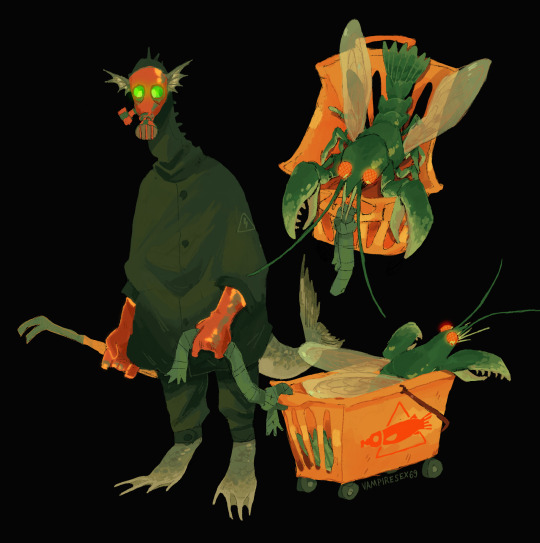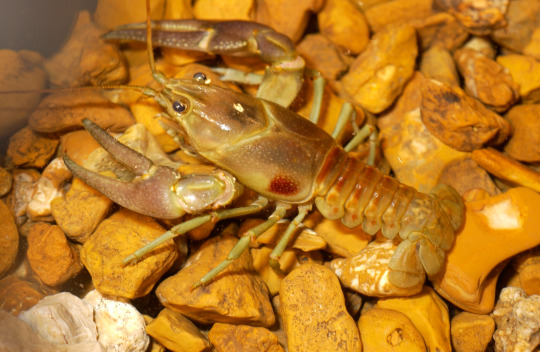#crawfish
Explore tagged Tumblr posts
Text
🦐A SINGLE MOM WHO WORKS TWO JOBS, WHO LOVES HER KIDS BUT NEVER STOPS🦐
#crawfish#🦐💕#she survived hell for a month and was rewarded the blessing of her ancestors#queen shit#video
56K notes
·
View notes
Text

Signal crawfish
#crawfish#crawdad#animals#wildlife#animal#forest#nature#beauty#photographers on tumblr#artists on tumblr#original photographers#original photography#photography#aesthetic#Washington#pnw#westcoastbestcoast#art#vsco#pacific northwest#explore#travel#cottagecore#p
2K notes
·
View notes
Text

scrap collector and her pet crawfish-fly-thing 🦞
2K notes
·
View notes
Photo

Source details and larger version.
162 notes
·
View notes
Text

x
149 notes
·
View notes
Text

the Thing got out today (5:30 in the morning) and woke me up by clattering as loudly as possible against my metal shelves. love and light
353 notes
·
View notes
Text





Recent-ish finds from Admin BT: another mug edition! (Various thrift stores in the Boise, ID area)
Sensuous Woman should have come home with me. I'm going back tomorrow to see if it is still there.
#louisiana#lobster#mugs#real estate#edgy#alice in wonderland#cats#fred#tourism#Admin BT's Finds#crawfish#oysters#shellfish#crabs
290 notes
·
View notes
Text
Wet Beast Wednesday: crayfish
It's week 3 of fresh-uary, the month where I only cover freshwater species for Wet Beast Wednesday. This week's topic is the crayfish, also known as the crawfish, crawdad, mudbug, lobster, yabby, kōura, and a lot of other names. The various names for crayfish are also applied to a variety of saltwater species that aren't the topic of today's post, so there's some confusion over terminology when discussing these creatures. Let me clear some of that up and explain why it's ok to be cray.

(Image: a red swamp crayfish (Procambarus clarkii), seen from the side. It is a long, lobster-like crustacean with a rigid front half and flexible tail ending in a wide fan. It walks on 8 legs and has a large pair of pincers held in front of the body. The head ends in a pointy snout with two eyes on short stalks and two pairs of antennae. This one is mostly red, with darker portions on the back. End ID)
The crayfish I'm covering today are freshwater members of the clade Astacidea. This clade also contains clawed lobsters, so there is a lot of similarity between the two groups. There are four families of crayfish, split between two superfamilies. These families are largely split up by region. The superfamily Astacoidea are known as northern hemisphere crayfish and contains the families Cambaroididae (found in eastern Asia), Astacidae (found in west Asia, Europe, and Western North America), and Cambaridae (found in eastern North America). The superfamily Parastacoidea, or southern hemisphere crayfish, contains the family Parastacidae, members of which live (or used to live) in South America, Madagascar, and Australia and New Zealand.

(Image: The Sydney spiny crayfish (Euastacus spinifer) seen from the side. It is a dark green in color, with orange outlines and orange and black spines around the body. End ID)
Crayfish are very similar to clawed lobsters in appearance and have a fairly typical decapod body plan. Their bodies consist of 20 segments grouped into two main body parts: the cephalothorax and abdomen. The cephalothorax is rigid, covered by the carapace, and contains the head and attachments for the legs. The head includes two stalked eyes, two sets of antennae, and a sideways opening mouth surrounded by leg-like maxillipeds that help manipulate food. As a decapod, crayfish have 10 legs. Like their clawed lobster cousins, crayfish use four pairs for walking while the front pair have been modified into a pair of large pincers used for defense and capturing food. Lost limbs can be regrown, though it takes a while. The abdomen forms the flexible "tail". Each segment of the abdomen contains a pair of appendages called pleopods or swimmeretes. These help circulate water and can be used to swim in juveniles. In males, the first pair of pleopods is modified into grasping structures used to hold onto the female during mating. The abdomen ends with a fan-like structure called the telson, that acts like a fin. By rapidly curling its abdomen beneath it, a crayfish can shoot backwards away from danger. The largest species of crayfish, and largest freshwater invertebrate, is Astacopsis gouldi, the giant Tasmanian freshwater crayfish. It can reach 80 cm (31 in) long and 6 kg (13 lbs), though such large individuals are rare. Most crayfish species are considerably smaller.

(Image: someone holding a giant Tasmanian crayfish up to the camera. It is extremely large for a crayfish, requiring two hands to hold and its pincers are roughly as long as the person's hands. It is a dark, swampy green to black in color, with many small lumps on the body. End ID)
Crayfish are benthic omnivores and detritovores found in both running and still water. Crayfish are opportunistic feeders with extremely varied diets that include plants, fungi, animals, microorganisms, and decaying organic matter. Mist species are considered primarily herbivorous and scavengers, though they will take live prey if the opportunity arises and have been known to be cannibalistic. Decomposing organic matter forms a large portion of the crayfish diet and they often eat it through the mud and slime found on the bottom of their habitats. A crayfish can quickly swallow mud, then internally sort it by the size of ingested particles. Coarser materials are processed and excreted faster. The digestive tract can process the dead plankton and decaying organic matter that makes up mud from the sediment. Feces are excreted wrapped in a peritrophic membrane. This membrane is rich in proteins and is usually eaten by the crayfish to regain them and get a second shot at digesting organic matter in the feces. Fresh vegetation is also a major food source and there are even reports of crayfish leaving the water to graze on land plants. Crayfish feed periodically, switching between periods of feeding and periods of hiding while they digest. As with all crustaceans, crayfish have to regularly molt their exoskeletons as they grow. They typically eat their old carapaces to regain the calcium carbonate and other molecules contained in the shell. After molting, it takes time for the new exoskeleton to harden, leaving the crayfish more vulnerable to injury or predation.

(Image: a small, orange crayfish in captivity inspecting a cucumber slice that is being offered as food. End ID)
Crayfish mate seasonally, usually in spring through late summer, triggered by changes in water temperature. The exact mating process depends on species, though females are likely to release pheromones to attract males. Males are initially aggressive, but often calm down sometime before mating. Males are known to fight over access to females. In some species, the male and female will touch claws and exchange chemical signatures prior to mating possibly as a courtship ritual. Males have also been seen attempting to mate with other males. Once a female accepts a mate, the male will flip her onto her back and align their abdomens, using his modified first pair of pleopods to grab on. Once their genitals are aligned, the male will pass a sac of sperm to the female using structures called gonopods. The male will leave after mating. The female lays clusters of eggs that are carefully attached to the pleopods. Until the eggs hatch, the mother will carry them with her, moving her pleopods to circulate water around them and using her legs to clean them. Egg development can takes days to weeks depending on species. The young are born well developed for crustaceans, looking like miniature adults. The female will shake her pleopods to help the hatchlings emerge. Juveniles are at a high risk of predation, including from other crayfish, so only a few of the possible hundreds of eggs will reach adulthood. It can take years for a crayfish to reach sexual maturity.

(Image: a series of 6 photos showing two blue crayfish mating. In the first three photos, the male turns the female on her back. In the 4th photo, the male starts to line up his abdomen with hers. In the 5th photo, the abdomens are aligned and mating is occurring. In the last photo, the male climbs off of the female. End ID. Source)

(Image: a female crayfish being held upside down to show her eggs, visible as small, black balls attached to the underside of the abdomen. End ID)
Crayfish are edible and eaten worldwide, with 95% of the world supply coming from China. Boiling is the most common form of cooking. Experiments have shown that crayfish take a while to die when boiled and show pain responses. They also release cortisol, a stress hormone, when boiled. There is, for some reason, a debate on whether or not crustaceans can feel pain. I think that it's obvious they have negative responses to negative stimuli and therefore it can be safely assumed that they can suffer. To more humanely cook a crayfish, freeze them for a few hours to render them unconscious, then cut down the body lengthwise to destroy the nervous system before boiling. Crayfish are also kept in aquariums as pets and can be fed shrimp pellets and plants, but they may also try to eat other organisms in the same tanks. In the wild, many species of crayfish are threatened by overfishing, habitat loss, climate change, and pollution. Most species need clean water and are highly vulnerable to pollutants. This allows crayfish to be used as an indicator species for the health of their environments. The pseudofungus Aphanomyces astaci causes a fatal disease called crayfish plague that has escaped from aquacultures to affect wild populations. Side note, I had no idea pseudofungi were a thing until right now. Multiple species of crayfish have become invasive species after accidental or intentional release of common food species. Other invasive species can outcompete or prey on native species.

(Image: the rusty crayfish (Faxonius rusticus), a common invasive species in North America, identifiable by the rust-red blotch located on the sides of the carapace near the rear of the cephalothorax. End ID)
#wet beast wednesday#crayfish#crawfish#crawdad#yabby#yabbies#kōura#mudbug#graphic crayfish sex#crustacean#invertebrates#invertiblr#freshwater#claws#ecology#biology#zoology#animal facts#informative#educational#image described
89 notes
·
View notes
Text

Haunting the caves is hard work, especially when you're this small. Sometimes all I really want is a hug.
Hell Creek Cave Crayfish (Cambarus zophonastes)
Arkansas, USA
Status: Endangered
#crayfish#crustacean#invertebrate#crawfish#troglobite#invertebrate art#bug art#inverts#endangered species#north america#usa#arkansas
56 notes
·
View notes
Text

awesome sand yabby 4 a client !!!!
#i like to draw fish#fish#fish art#fishblr#small artist#digital art#digital illustration#digital drawing#sandyabby#yabby#crawfish#crustacean
82 notes
·
View notes
Text



Anybody seen a crawfish that looks like this?? I live in southern Missouri and I’ve never seen one this color or even close to being orange.
Why is this?? I’m stumped.
#animal#animal questions#crawfish#crayfish#shellfish#wildlife#creek animals#why he look like that#outdoors#nature#wild living#craw daddy#craw dad#forest#camping
129 notes
·
View notes
Text

Image by Ryan Hodnett, CC BY-SA 4.0
98 notes
·
View notes
Text
hello everyone

crawfish
#crayfish i understand but if you call them crawdads i will start crying /j#crawfish#what the hell. how do i tag this.#art#crustacean#crayfish
33 notes
·
View notes
Text









Day 1: favourite animal - crawfish 🦞
🦞/💙/🦞 | 🦞/💙/🦞 | 🦞/💙/🦞
#gifs that don't have a source linked are from videos that i took myself#stim blog#stimblr#stimboard#visual stim#stim gifs#crawfish#crayfish
34 notes
·
View notes
Text


Please vote for whichever animal is cuter, not whichever one you like more!
#Tumblr tournament#tournament#bracket#poll#poll blog#cute animals#baby animals#cute#animals#zoology#biology#Least weasel#weasel#crayfish#crawfish#crawdad
95 notes
·
View notes
